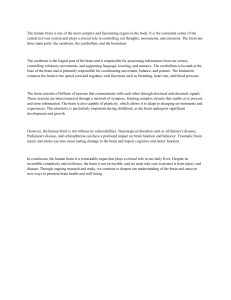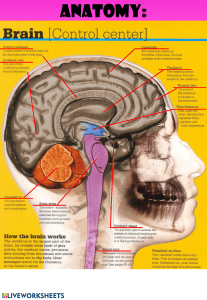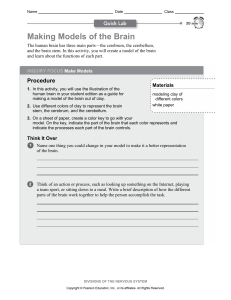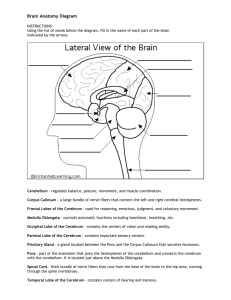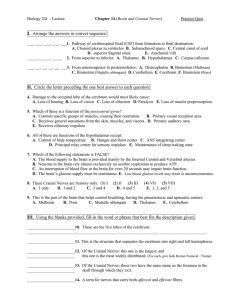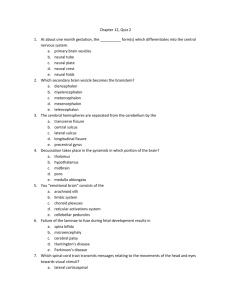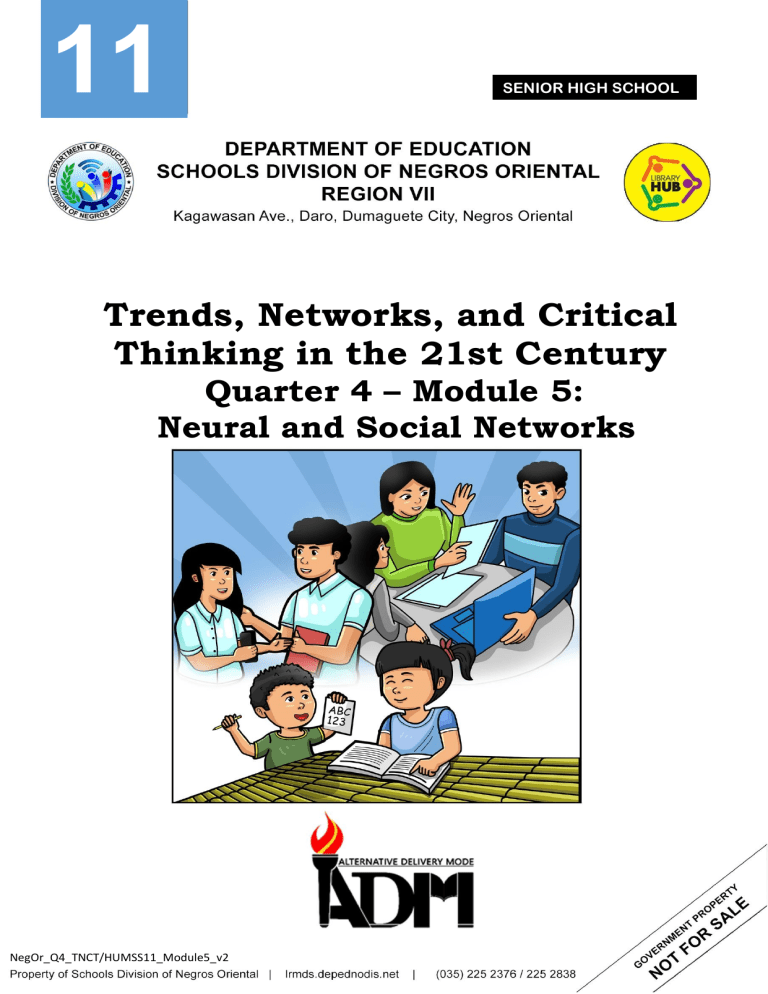
11 SENIOR HIGH SCHOOL Trends, Networks, and Critical Thinking in the 21st Century Quarter 4 – Module 5: Neural and Social Networks NegOr_Q4_TNCT/HUMSS11_Module5_v2 Trends, Networks, and Critical Thinking in the 21st Century – Grade 11 Alternative Delivery Mode Quarter 4 – Module 5: Neural and Social Networks Second Edition, 2021 Republic Act 8293, Section 176 states that: No copyright shall subsist in any work of the Government of the Philippines. However, prior approval of the government agency or office wherein the work is created shall be necessary for exploitation of such work for profit. Such agency or office may, among other things, impose as a condition the payment of royalties. Borrowed materials (i.e., songs, stories, poems, pictures, photos, brand names, trademarks, etc.) included in this module are owned by their respective copyright holders. Every effort has been exerted to locate and seek permission to use these materials from their respective copyright owners. The publisher and authors do not represent nor claim ownership over them. Published by the Department of Education Secretary: Leonor Magtolis - Briones Undersecretary: Diosdado M. San Antonio Development Team of the Module Writer: Cherry Lyn Ozoa-Sulitana Editor: Bryan Miko M. Cadiz Reviewers: Divina May S. Medez, Catherine A. Credo Illustrator: Typesetter Layout Artists: Jessie V. Alcala, Aileen Rose N. Cruz, Enrey P. Alam-alam Management Team: Senen Priscillo P. Paulin, CESO V Rosela R. Abiera Joelyza M. Arcilla, Ed.D. Maricel S. Rasid Marcelo K. Palispis, Ed.D. Elmar L. Cabrera Nilita L. Ragay, Ed.D. Carmelita A. Alcala, Ed.D. Printed in the Philippines by ________________________ Department of Education –Region VII Schools Division of Negros Oriental Office Address: Tele #: E-mail Address: Kagawasan, Ave., Daro, Dumaguete City, Negros Oriental (035) 225 2376 / 541 1117 negros.oriental@deped.gov.ph i Introductory Message This Self-Learning Module (SLM) is prepared so that you, our dear learners, can continue your studies and learn while at home. Activities, questions, directions, exercises, and discussions are carefully stated for you to understand each lesson. Each SLM is composed of different parts. Each part shall guide you step-by-step as you discover and understand the lesson prep ared for you. Pre-tests are provided to measure your prior knowledge on lessons in each SLM. This will tell you if you need to proceed on completing this module or if you need to ask your facilitator or your teacher’s assistance for better understanding of the lesson. At the end of each module, you need to answer the post-test to self-check your learning. Answer keys are provided for each activity and test. We trust that you will be honest in using these. In addition to the material in the main text, Notes to the Teacher are also provided to our facilitators and parents for strategies and reminders on how they can best help you on your home-based learning. Please use this module with care. Do not put unnecessary marks on any part of this SLM. Use a separate sheet of paper in answering the exercises and tests. And read the instructions carefully before performing each task. If you have any questions in using this SLM or any difficulty in answering the tasks in this module, do not hesitate to consult your teacher or facilitator. Thank you. ii What I Need to Know This Learning Module is an alternative instructional design that uses developed instructional materials which are based on the needs of the students. They are encouraged to independently work on the different activities with the primary aim of developing them to be productive people in the society. This course presents some relevant information about neural and social networks which can be applied in facing challenges in our world today. You shall be able to learn some skills and ideas that you may use for your daily living in this democratic society. By studying this module, you will learn not to abuse the independence you have and appreciate its value. You will also become a productive citizen by understanding your role in the society as a whole. Thus, you could be an influence of “change for the better” in this challenging world. Happy learning! What I Know Directions: Read each item carefully and write the letter of the best answers in your activity notebook. 1. What are social networks? a. Society coming together to do good things. b. A network of strangers that get to know each other. c. A network of social interactions and personal relationships d. A network of an online gaming community 2. Which of the following is an important characteristic of social networks? a. They are important platforms for sending email b. They are made of social interactions between people c. They are used for storing network configuration details d. None of these answers are correct 3. The graphical representation of a social network analysis is made up of links and ___________. a. People b. Networks c. Nodes d. Computers 1 NegOr_Q4_TNCT/HUMSS11_Module5_v2 4. _____ can be used to describe nodes that contain the most amount of information about a network. a. Social Networks c. Degree Centrality b. Betweenness Centrality d. Broadcasters 5. This system controls everything you do. a. Nervous system c. Respiratory system b. Olfactory system d. Endocrine system 6. Without the nervous system, you wouldn’t be able to ____. a. Walk b. Breathe c. Think d. All of the above 7. The nervous system is made up of these three parts: a. Brain, heart, and spinal cord c. Nerves, arteries, and veins b. Brain, spinal cord, and nerves d. Nerves, liver, and heart 8. Which part of the body is the control center for the nervous system? a. Spinal cord b. Stomach c. Brain d. Heart 9. A typical brain weighs how much? a. 3 pounds (1.4 kilograms) b. 3 ounces (85 grams) c. 3 tons (2.7 metric tons) d. 3 kilograms (6.6 pounds) 10. What is the biggest part of the brain? a. Brain stem c. Cerebrum b. Think tank d. Cerebellum 2 NegOr_Q4_TNCT/HUMSS11_Module5_v2 What’s In Task 1: Connect Them All Directions: Tick at least five item or concepts that emphasize good relationship. Then think of situations when you applied or experienced such concepts in your family, school, or neighborhood. Write your answer in your notebook. CONCEPTS Understanding Humility Jealousy Love Trust Greed Patience SITUATIONS APPLIED/EXPERIENCED I had a fight with my sister/brother ______________________________________________ ______________________________________________ ______________________________________________ ______________________________________________ ______________________________________________ ______________________________________________ What’s New Task 2: Relate Them All Directions: From the concepts that you have ticked in Task 1, indicate what network devices/technology you were able to use in maintaining good relationships. Write your answer in your notebook. CONCEPTS Understanding e ___________ ___________ ___________ ___________ ___________ NETWORK USED I called my sister using my cellular phone ___________________________________________________ ___________________________________________________ ___________________________________________________ ___________________________________________________ ___________________________________________________ 3 NegOr_Q4_TNCT/HUMSS11_Module5_v2 What is It INTRODUCTION A network is a group of individuals who collaborates with each other to be able to achieve a purpose and connection. It can be best described as work team, meeting of learners of the same course and profession, or any group who works together for a common cause. Establishing a network is important because through pooling resources, the organization can be aware of potential threats or problems that may arise during a project or event. Networking is associated with participation since it builds support and allows empowerment of its members. It also strengthens the work team to advocate issues, provide credibility, attain outcomes, give accurate information, plan activities, support project, and solve potential problems. Networking allows people to be flexible as they adjust to the changing environment. These individuals depend on different lifelong learning skills that they use in their interaction with their peers and workmates. Networking further connects and gathers people from a heterogeneous group of individuals from across professions and classes to achieve their plans and goals. It pivots innovations and awareness as people exchange knowledge and information. Weak and strong networks provide learning that will give organizations and people an idea of how links and connections work. Thus, an individual may devise methods and ties to his or her learning needs and use technology to enhance such skills. Connection refers to something that joins two or more objects or individuals. It also shows a situation wherein two or more objects or individuals have a similar cause, goal, or origin. The participants of Occupy movements, for instance, were connected together by a common goal of socioeconomic justice. Connection also exists between two individuals (or among many), events, and objects. Global warming is connected to frequent forest fires, just as unemployment is connected to poverty. Similarly, a relationship refers to the state or condition of being connected; the way in which two or more individuals or groups regard and behave toward one another; the manner by which two or more people, associations, or countries deal with each. The annual Asia-Pacific Economic Cooperation (APEC) meeting of heads of state demonstrates a relationship between economies around the Pacific belt. A relationship always involves dyadic or more levels of connection. EXPLORE Relationships have different meanings to different people. Such can be with friends, with a special someone, with colleagues and co-workers, with co-members of an association, and with family members, to name a few. Establishing relationships is an important component of your life. As you pass through the different life stages, you will meet a variety of people with whom you’ll build relationships with, whether good or bad, some of which will leave long-lasting impacts on your life. 4 NegOr_Q4_TNCT/HUMSS11_Module5_v2 Establishing good relationships with friends is essential. Doing things for each other without expecting anything in return makes a good friendship. Building good relationships with colleagues and coworkers can be an asset to your work success. A promotion, a raise, or an appreciation from your company may come out due to your low-quality work backed up by good relationships with coworkers and the management. Love and respect for others are basic in establishing good and inspiring relationships in your workplace. Familial relationships are believed to be the most important of all types of relationship. Good relationship between parents and children results in a happy, wholesome home. Studies have shown that children who grew up with good relationships with their parents acquired good attitudes, got better grades, and became better decision makers. They also developed the tendency to listen to the advice of their parents, thus, avoiding misdirection and costly mistakes in life. Quality matters in any relationship. Sincerity, depth, and mutual understanding underlie a good relationship of any kind. Being a social actor, you are always engaged in overlapping relationships. Relationships, therefore, play a vital role in life. NEURAL NETWORK The human brain is the command center for the human nervous system. It receives signals from the body's sensory organs and outputs information to the muscles. The human brain has the same basic structure as other mammal brains but is larger in relation to body size than any other brains.4 The brain is an amazing three-pound organ that controls all functions of the body, interprets information from the outside world, and embodies the essence of the mind and soul. Intelligence, creativity, emotion, and memory are a few of the many things governed by the brain. Protected within the skull, the brain is composed of the cerebrum, cerebellum, and brainstem. Figure 1. The brain has three main parts: the cerebrum, cerebellum and brainstem. The brain receives information through our five (Hines 2018) senses: sight, smell, touch, taste, and hearing—often many at one time. It assembles the messages in a way that has meaning for us, and can store that information in our memory. The brain controls our thoughts, memory and speech, movement of the arms and legs, and the function of many organs within our body. The central nervous system (CNS) is composed of the brain and spinal cord. The peripheral nervous system (PNS) is composed of spinal nerves that branch from the spinal cord and cranial nerves that branch from the brain. The brain is composed of the cerebrum, cerebellum, and brainstem (Fig. 1). 5 NegOr_Q4_TNCT/HUMSS11_Module5_v2 Cerebrum is the largest part of the brain and is composed of right and left hemispheres. It performs higher functions like interpreting touch, vision and hearing, as well as speech, reasoning, emotions, learning, and fine control of movement. Cerebellum is located under the cerebrum. Its function is to coordinate muscle movements, maintain posture, and balance. Brainstem acts as a relay center connecting the cerebrum and cerebellum to the spinal cord. It performs many automatic functions such as breathing, heart rate, body temperature, wake and sleep cycles, digestion, sneezing, coughing, vomiting, and swallowing. Right Brain–Left Brain The cerebrum is divided into two halves: the right and left hemispheres (Fig. 2) They are joined by a bundle of fibers called the corpus callosum that transmits messages from one side to the other. Each hemisphere controls the opposite side of the body. If a stroke occurs on the right side of the brain, your left arm or leg may be weak or paralyzed. Not all functions of the hemispheres are shared. In general, the left hemisphere controls speech, comprehension, arithmetic, and writing. The right hemisphere controls creativity, spatial ability, artistic, and musical skills. The left hemisphere is dominant in hand use and language in about 92% of people. Figure 2. The cerebrum is divided into left and right hemispheres. The two sides are connected by the nerve fibers corpus callosum. (Hines 2018) Lobes of the Brain The cerebral hemispheres have distinct fissures, which divide the brain into lobes. Each hemisphere has 4 lobes: frontal, temporal, parietal, and occipital (Fig. 3). Each lobe may be divided, once again, into areas that serve very specific functions. It is important to understand that each lobe of the brain does not function alone. There are very complex relationships between the lobes of the brain and between the right and left hemispheres. Frontal lobe • Personality, behavior, emotions • Judgment, planning, problem solving • Speech: speaking and writing (Broca’s area) • Body movement (motor strip) • Intelligence, concentration, self-awareness Figure 3. The cerebrum is divided into four lobes: frontal, parietal, occipital, and temporal. (Hines 2018) 6 NegOr_Q4_TNCT/HUMSS11_Module5_v2 Parietal lobe • Interprets language, words • Sense of touch, pain, temperature (sensory strip) • • Interprets signals from vision, hearing, motor, sensory and memory Spatial and visual perception Occipital lobe • Interprets vision (color, light, movement) Temporal lobe • Understanding language (Wernicke’s area) • Memory • Hearing • Sequencing and organization Language In general, the left hemisphere of the brain is responsible for language and speech and is called the "dominant" hemisphere. The right hemisphere plays a large part in interpreting visual information and spatial processing. In about one third of people who are left-handed, speech function may be located on the right side of the brain. Lefthanded people may need special testing to determine if their speech center is on the left or right side prior to any surgery in that area. Aphasia is a disturbance of language affecting speech production, comprehension, reading or writing, due to brain injury—most commonly from stroke or trauma. The type of aphasia depends on the brain area damaged. Broca’s area lies in the left frontal lobe (Fig. 3). If this area is damaged, one may have difficulty moving the tongue or facial muscles to produce the sounds of speech. The person can still read and understand spoken language but has difficulty in speaking and writing (i.e., forming letters and words, doesn't write within lines)—called Broca's aphasia. Wernicke's area lies in the left temporal lobe (Fig. 3). Damage to this area causes Wernicke's aphasia. The individual may speak in long sentences that have no meaning, add unnecessary words, and even create new words. They can make speech sounds; however, they have difficulty understanding speech and are therefore unaware of their mistakes. Cortex The surface of the cerebrum is called the cortex. It has a folded appearance with hills and valleys. The cortex contains 16 billion neurons (the cerebellum has 70 billion = 86 billion total) that are arranged in specific layers. The nerve cell bodies color the cortex grey-brown giving it its name—gray matter (Fig. 4). Beneath the cortex are long nerve fibers (axons) that connect brain areas to each other—called white matter. The folding of the cortex increases the brain’s surface area allowing more neurons to fit inside the skull and enabling higher functions. Each fold is called a gyrus, 7 NegOr_Q4_TNCT/HUMSS11_Module5_v2 and each groove between folds is called a sulcus. There are names for the folds and grooves that help define specific brain regions. Deep Structures Pathways called white matter tracts connect areas of the cortex to each other. Messages can travel from one gyrus to Figure 4. The cortex contains neurons (grey another, from one lobe to another, from one matter), which are interconnected to other brain side of the brain to the other, and to areas by axons (white matter). The cortex has a folded appearance. A fold is called a gyrus and structures deep in the brain (Fig. 5). Hypothalamus is located in the floor of the the valley between is a sulcus. (Hines 2018) third ventricle and is the master control of the autonomic system. It plays a role in controlling behaviors such as hunger, thirst, sleep, and sexual response. It also regulates body temperature, blood pressure, emotions, and secretion of hormones. Pituitary gland lies in a small pocket of bone at the skull base called the sella turcica. The pituitary gland is connected to the hypothalamus of the brain by the pituitary stalk. Known as the “master gland,” it controls other endocrine glands in the body. It secretes hormones that control sexual development, promote bone and muscle growth, and respond to stress. Pineal gland is located behind the third ventricle. It helps regulate the body’s internal clock and circadian rhythms by secreting melatonin. It has some role in sexual development. Thalamus serves as a relay station for almost all information that comes and goes to the cortex. It plays a role in pain sensation, attention, alertness and memory. Basal ganglia include the caudate, putamen and globus pallidus. These nuclei work with the cerebellum to coordinate fine motions, such as fingertip movements. Figure 5. Coronal cross-section showing the basal ganglia. (Hines 2018) Limbic system is the center of our emotions, learning, and memory. Included in this system are the cingulate gyri, hypothalamus, amygdala (emotional reactions) and hippocampus (memory). Memory Memory is a complex process that includes three phases: encoding (deciding what information is important), storing, and recalling. Different areas of the brain are involved in different types of memory (Fig. 6). Your brain has to pay attention and rehearse in order for an event to move from short-term to long-term memory—called encoding. 8 NegOr_Q4_TNCT/HUMSS11_Module5_v2 • • • Short-term memory, also called working memory, occurs in the prefrontal cortex. It stores information for about one minute and its capacity is limited to about 7 items. For example, it enables you to dial a phone number someone just told you. It also intervenes during reading, to memorize the sentence you have just read, so that the next one makes sense. Long-term memory is processed in the hippocampus of the temporal lobe and is activated when you want to memorize something for a longer time. This memory has unlimited content and duration capacity. It contains personal memories as well as facts and figures. Skill memory is processed in the cerebellum, which relays information to the basal ganglia. It stores automatic learned memories like tying a shoe, playing an instrument, or riding a bike. Figure 6. Structures of the limbic system involved in memory formation. The prefrontal cortex holds recent events briefly in shortterm memory. The hippocampus is responsible for encoding long-term memory. (Hines 2018) Ventricles and cerebrospinal fluid The brain has hollow fluid-filled cavities called ventricles (Fig. 7). Inside the ventricles is a ribbon-like structure called the choroid plexus that makes clear colorless cerebrospinal fluid (CSF). CSF flows within and around the brain and spinal cord to help cushion it from injury. This circulating fluid is constantly being absorbed and replenished. There are two ventricles deep within the cerebral hemispheres called the lateral ventricles. They both connect with the third ventricle through a separate opening called the foramen of Monro. The third ventricle connects with the fourth ventricle through a long narrow tube called the aqueduct of Sylvius. From the fourth ventricle, CSF flows into the subarachnoid space where it bathes and cushions the brain. CSF is recycled (or absorbed) by special structures in the superior sagittal sinus called arachnoid villi. Figure 7. CSF is produced inside the ventricles deep within the brain. CSF fluid circulates inside the brain and spinal cord and then outside to the subarachnoid space. Common sites of obstruction: (1) foramen of Monro, (2) aqueduct of Sylvius, and (3) obex. (Hines 2018) 9 NegOr_Q4_TNCT/HUMSS11_Module5_v2 A balance is maintained between the amount of CSF that is absorbed and the amount that is produced. A disruption or blockage in the system can cause a build-up of CSF, which can cause enlargement of the ventricles (hydrocephalus) or cause a collection of fluid in the spinal cord (syringomyelia). Skull The purpose of the bony skull is to protect the brain from injury. The skull is formed from eight bones that fuse together along suture lines. These bones include the frontal, parietal (2), temporal (2), sphenoid, occipital, and ethmoid (Fig. 8). The face is formed from 14 paired bones including the maxilla, Figure 8. The brain is protected zygoma, nasal, palatine, lacrimal, inferior nasal inside the skull. The skull is formed from eight bones. conchae, mandible, and vomer. (Hines 2018) Inside the skull are three distinct areas: anterior fossa, middle fossa, and posterior fossa (Fig. 9). Doctors sometimes refer to a tumor’s location by these terms, e.g., middle fossa meningioma. Similar to cables coming out the back of a computer, all the arteries, veins and nerves exit the base of the skull through holes, called foramina. The big hole in the middle (foramen magnum) is where the spinal cord exits. Cranial nerves The brain communicates with the body through the spinal cord and twelve pairs of cranial nerves (Fig. 9). Ten of the twelve pairs of cranial nerves that control hearing, eye movement, facial sensations, taste, swallowing and movement of the face, neck, shoulder and tongue muscles originate in the brainstem. The cranial nerves for smell and vision originate in the cerebrum. The Roman numeral, name, and main function of the twelve cranial nerves: Figure 9. A view of the cranial nerves at the base of the skull with the brain removed. Cranial nerves originate from the brainstem, exit the skull through holes called foramina, and travel to the parts of the body they innervate. The brainstem exits the skull through the foramen magnum. The base of the skull is divided into 3 regions: anterior, middle and posterior fossae. (Hines 2018) 10 NegOr_Q4_TNCT/HUMSS11_Module5_v2 Number I II III IV V VI VII VIII IX X XI XII Name Function Olfactory Optic Oculomotor Trochlear Trigeminal Abducens Facial Vestibulocochlear Glossopharyngeal Vagus Accessory Hypoglossal Smell Sight Moves eye, pupil Moves eye Face sensation Moves eye Moves face, salivate Hearing, balance Taste, swallow Heart rate, digestion Moves head Moves tongue Meninges The brain and spinal cord are covered and protected by three layers of tissue called meninges. From the outermost layer inward, they are: the dura mater, arachnoid mater, and pia mater. Dura mater is a strong, thick membrane that closely lines the inside of the skull; its two layers, the periosteal and meningeal dura, are fused and separate only to form venous sinuses. The dura creates little folds or compartments. There are two special dural folds, the falx and the tentorium. The falx separates the right and left hemispheres of the brain and the tentorium separates the cerebrum from the cerebellum. Arachnoid mater is a thin, web-like membrane that covers the entire brain. The arachnoid is made of elastic tissue. The space between the dura and arachnoid membranes is called the subdural space. Pia mater hugs the surface of the brain following its folds and grooves. The pia mater has many blood vessels that reach deep into the brain. The space between the arachnoid and pia is called the subarachnoid space. It is here where the cerebrospinal fluid bathes and cushions the brain. Figure 10. The common carotid artery courses up the neck and divides into the internal and external carotid arteries. The brain’s anterior circulation is fed by the internal carotid arteries (ICA) and the posterior circulation is fed by the vertebral arteries (VA). The two systems connect at the Circle of Willis (green circle). (Hines 2018) 11 NegOr_Q4_TNCT/HUMSS11_Module5_v2 Blood supply Blood is carried to the brain by two paired arteries, the internal carotid arteries and the vertebral arteries (Fig. 10). The internal carotid arteries supply most of the cerebrum. The vertebral arteries supply the cerebellum, brainstem, and the underside of the cerebrum. After passing through the skull, the right and left vertebral arteries join together to form the basilar artery. The basilar artery and the internal carotid arteries “communicate” with each other at the base of the brain called the Circle of Willis (Fig. 11). The communication between the internal carotid and vertebral-basilar systems is an important safety feature of the brain. If one of the major vessels becomes blocked, it is possible for collateral blood flow to come across the Circle of Willis and prevent brain damage. The venous circulation of the brain is very different from that of the rest of the body. Usually, arteries and veins run together as they supply and drain specific areas of the body. So, one would think there would be a pair of vertebral veins and internal carotid veins. However, this is not the case in the brain. The major vein collectors are integrated into the dura to form venous sinuses — not to be confused with the air sinuses in the face and nasal region. The venous sinuses collect the blood from the brain and pass it to the internal jugular veins. The superior and inferior sagittal sinuses drain the cerebrum, the cavernous sinuses drain the anterior skull base. All sinuses eventually drain to the sigmoid sinuses, which exit the skull and form the jugular veins. These two jugular veins are essentially the only drainage of the brain. Cells of the brain The brain is made up of two types of cells: nerve cells (neurons) and glia cells. Nerve cells There are many sizes and shapes of neurons, but all consist of a cell body, dendrites and an axon. The neuron conveys information through electrical and chemical signals. Try to picture electrical wiring in your home. An electrical circuit is made up of numerous wires connected in such a way that when a light switch is turned on, a light bulb will beam. A neuron that is excited will transmit its energy to neurons within its vicinity. Neurons transmit their energy, or “talk”, to each other across a tiny gap called a synapse (Fig. 12). Figure 11. Top view of the Circle of A neuron has many arms called dendrites, which Willis. The internal carotid and act like antennae picking up messages from other vertebral-basilar systems are joined by nerve cells. These messages are passed to the cell the anterior communicating (Acom) and posterior communicating (Pcom) body, which determines if the message should be arteries. passed along. Important messages are passed to (Hines 2018) the end of the axon where sacs containing neurotransmitters open into the synapse. The 12 NegOr_Q4_TNCT/HUMSS11_Module5_v2 neurotransmitter molecules cross the synapse and fit into special receptors on the receiving nerve cell, which stimulates that cell to pass on the message. Glia Cells Glia (Greek word meaning glue) are the cells of the brain that provide neurons with nourishment, protection, and structural support. There are about 10 to 50 times more glia than nerve cells and are the most common type of cells involved in brain tumors. • • • stroglia or astrocytes are the caretakers— they regulate the blood brain barrier, allowing nutrients and molecules to interact with neurons. They control homeostasis, neuronal defense and repair, scar formation, and also affect electrical impulses. Oligodendroglia cells create a fatty substance called myelin that insulates axons – allowing electrical messages to travel faster. Ependymal cells line the ventricles and secrete cerebrospinal fluid (CSF). Microglia are the brain’s immune cells, protecting it from invaders and cleaning up debris. They also prune synapses. Facts about the human brain • The human brain is the largest brain of all vertebrates relative to body size • It weighs about 3.3 lbs. (1.5 kilograms) • The average male has a brain volume of 1,275 cubic centimeters • The average female has a brain volume of 1,131 cubic centimeters • The brain makes up about 2% of a human’s body weight • The cerebrum makes up 85% of the brain’s weight • It contains about 86 billion nerve cells (neurons)—the “gray matter” • It contains billions of nerve fibers (axons and dendrites)—the “white matter” • These neurons are connected by trillions of connections or synapses. Figure 12. Nerve cells consist of a cell body, endrites and axon. Neurons communicate with each other by exchanging neurotransmitters across a tiny gap called a synapse. (Hines 2018) 13 NegOr_Q4_TNCT/HUMSS11_Module5_v2 Comparison between neural network and social network Links Purpose Location Source of message Receiver of message Transmission of message Time frame of transmission and reception of message Reaction or feedback Boundary Neural Network Nerve cells • To keep proper physical and mental functioning of the body • To keep the body alive Human head Brain Specific part of the body Neuron connections Within seconds; fast speed Normally an action specific or appropriate to the body part Human body Social Network People • To maintain kinship ties • To show common interests Community Person Individual members • Verbal and nonverbal • Use of technology Varying speed Varied reactions Group, association, club What’s More Task 3: Why, oh, why? Imagine how the feeling of joy or anger, as a message, is transmitted from the stimulus to the spinal cord, the brain, and other concerned parts of the body. Show the facial expression of joy (draw an emoji with your perception of the face of joy). Why is the facial expression of joy different from that of anger? (Explain in 3–5 sentences.). Write your answer in your notebook. 14 NegOr_Q4_TNCT/HUMSS11_Module5_v2 What I Have Learned I have learned that the brain is ________________________________ ___________________________________________________ ___ I have realized that I will always use my brain because ____________________________________________________ What I Can Do Task 4: Sketching It Out You are a freelance illustrator and comic artist. You want to apply as a regular contributor for a popular comics publication. They are in need of a comic strip about Filipino kinship relations covering the nuclear family and relatives. They asked you to submit a six-page, colored illustrated story showing the following features: good traits and values that the family members possess; dealing with conflicts and settling differences; and methods they employ in decision-making. It is up to you to select the issue in which the story would revolve on. The editorial board of the publication will evaluate your work based on the following criteria: • content (specified features, sequence of story, grammar and spelling, and relevant scenarios) ….10 points • creativity (well-designed characters, simple and witty text) ….10 points 15 NegOr_Q4_TNCT/HUMSS11_Module5_v2 Assessment Directions: Read each item carefully and write the letter of the best answer in your activity notebook. 1. The command center for the human nervous system a. heart b. eyes c. human brain d. internal organs 2. The brain receives information through the ___________ senses. a. 10 b. 7 c. 6 d. 5 3. The largest part of the brain. a. Cerebellum b. Cerebrum c. Brain stem d. Neurons 4. The coordinates muscle movements and maintains posture and balance. a. Cerebellum b. Cerebrum c. Brain stem d. Neurons 5. Performs many automatic functions such as breathing, heart rate, body temperature, wake and wake and sleep cycles, digestion, sneezing, coughing, vomiting, and swallowing. a. Cerebellum b. Cerebrum c. Brain stem d. Neurons 6. Plays a role in controlling behaviors such as hunger, thirst, sleep, and sexual response. It also regulates body temperature, blood pressure, emotions, and secretion of hormones. a. Hypothalamus b. Pineal gland c. Pituitary gland d. Thalamus 7. Plays a role in pain sensation, attention, alertness and memory. a. Hypothalamus b. Pineal gland c. Pituitary gland d. Thalamus 8. It helps regulate the body’s internal clock and circadian rhythms by secreting melatonin. a. Hypothalamus b. Pineal gland c. Basal ganglia d. Limbic system 9. The center of our emotions, learning, and memory a. Hypothalamus b. Pineal gland c. Basal ganglia d. Limbic system 10. It works with the cerebellum to coordinate fine motions, such as fingertip movements. a. Hypothalamus b. Pineal gland c. Basal ganglia d. Limbic system 16 NegOr_Q4_TNCT/HUMSS11_Module5_v2 Answer Key What’s In Task 1: Connect Them All Answers may vary What’s New Task 2: Relate them all Answers may vary What’s More Task 3: Why, oh, why? Answers may vary What Can I Do Task 4: Sketching It Out Answers may vary 17 NegOr_Q4_TNCT/HUMSS11_Module5_v2 References BOOKS: Rajagopal, K., Brinkie, DJ., Bruggen, JV., Sloep, PB. (2012) Understanding Personal Learning Networks: Their Structure, Content and the Networking Skills Needed to Optimally Use Them Urgel, Elizabeth T. (2017) Diwa Senior High School Series: Trends, Networks, and Critical Thinking in the 21st Century Culture. Makati: Diwa Learning Systems. P 169– 174 WEBSITES: Zimmerman, KA. (2018) Nervous System: Facts, Function and Diseases. Accessed at: https://www.livescience.com/22665-nervous-system.html. Accessed on: 15 September 2020 Lewis, T. Human Brain: Facts, Functions & Anatomy. Live Science. Accessed at: https://www.livescience.com/29365-human-brain.html. Accessed on: 16 September 2020. Mayfield Brain & Spine. Anatomy of the Brain. Accessed https://mayfieldclinic.com/pe-anatbrain.htm. Accessed on: 16 September 2020. at: PICTURES: Hines, Tonya. 2018. Mayfield Brain and Spine. Accessed January 14, 2022. http://www.mayfieldclinic.com/peanatbrain.htm?utm_content=buffer4b726&utm_medium=social&utm_source= pinterest.com&utm_campaign=buffer. 18 NegOr_Q4_TNCT/HUMSS11_Module5_v2 For inquiries or feedback, please write or call: Department of Education – Schools Division of Negros Oriental Kagawasan, Avenue, Daro, Dumaguete City, Negros Oriental Tel #: (035) 225 2376 / 541 1117 Email Address: negros.oriental@deped.gov.ph Website: lrmds.depednodis.net
